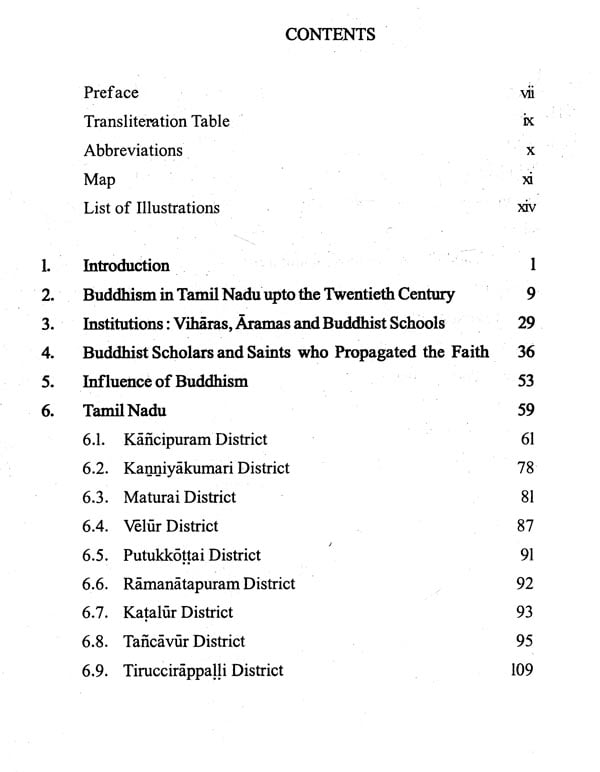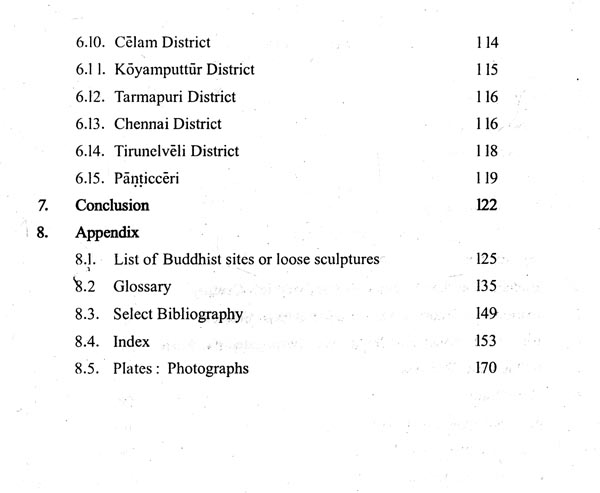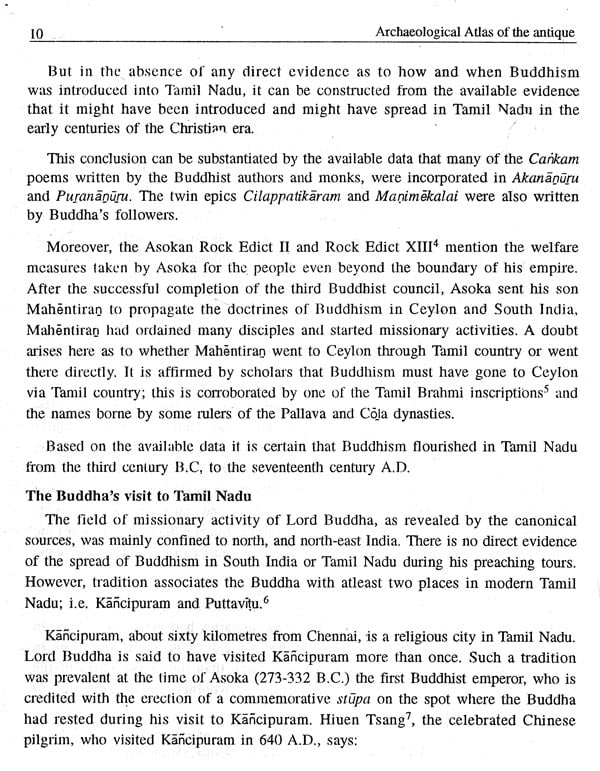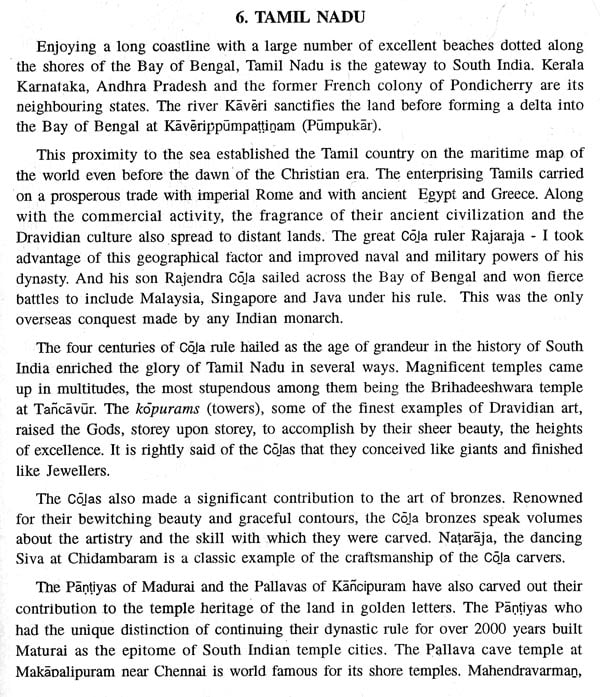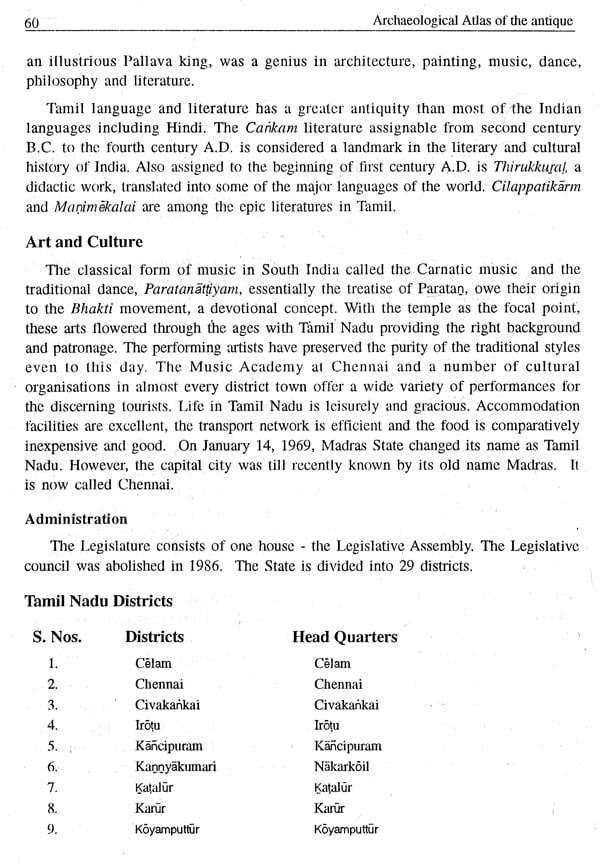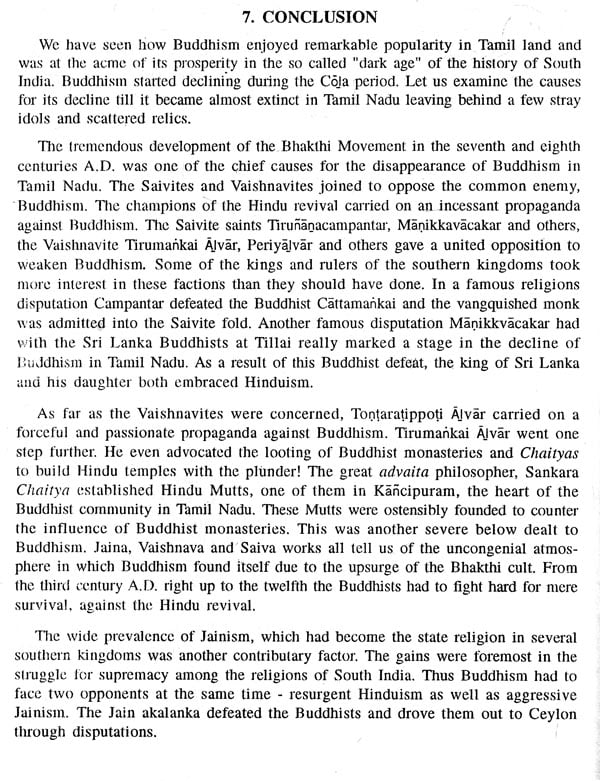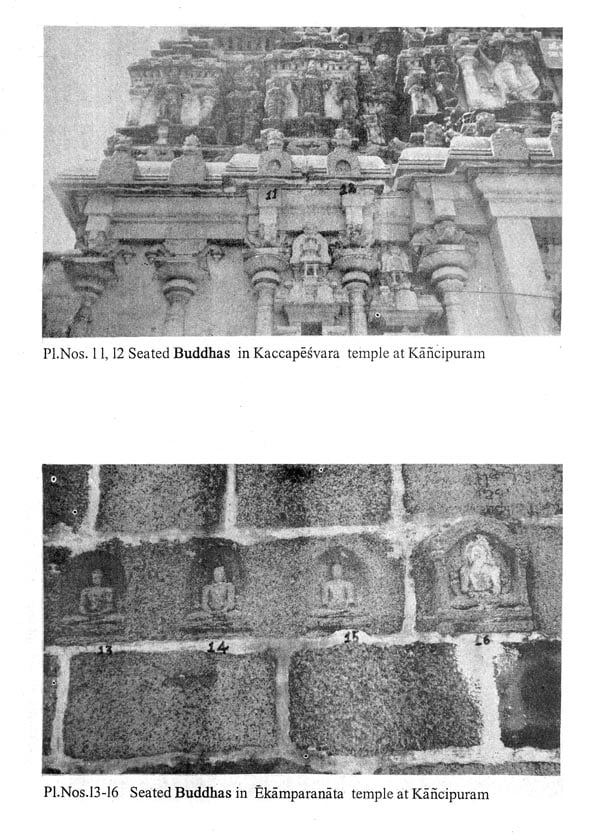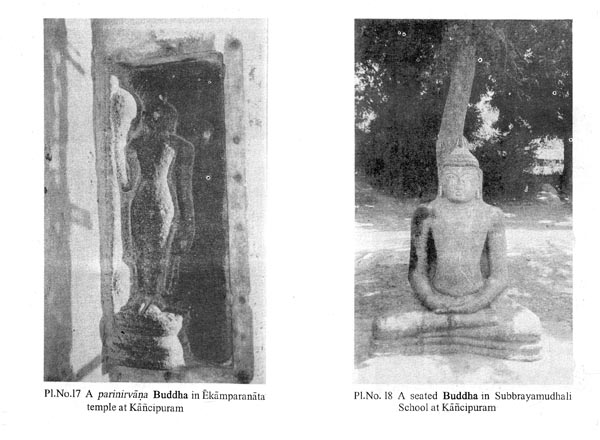
Archaeological Atlas of The Antique Remains of Buddhism in Tamil Nadu (An Old and Rare Book)
Book Specification
| Item Code: | NAY769 |
| Author: | G. John Samuel |
| Publisher: | Institute of Asian Studies, Chennai |
| Language: | English |
| Edition: | 1997 |
| Pages: | 238 (140 B/W Illustrations) |
| Cover: | PAPERBACK |
| Other Details | 9.50 X 7.00 inch |
| Weight | 450 gm |
Book Description
Mahatma Gandhi declared more than seven decades ago that Buddhism "is pre-eminently a religion of the masses." The implication of the statement is that Buddhism, one of the most evolved and natural religions of the world, teaches the common man, how to grow, how to liberate oneself, how to attain freedom from bondage. Free from obscurantist beliefs, rituals and miracles, this world religion supplies vital energy to the human being to seek the meaning of Life. It is no wonder it held sway over the Masses. Books on the origin and growth on Buddhism in Tamil Nadu have been written by the pioneers in the field such as C. Minakshi, T.N. Ramachandran, Dipak Kumar Barua, T.N. Vasudeva Rao, D.C. Ahir, H. Dhammaratna Tera, A. Aiyappan, P.R. Srinivasan, S. N. Kandasamy, Shu Hikosaka and others from whom I have drawn inspiration for this work. This slender volume is a humble effort at providing basic information on practical matters relating to the cultural and antique remains of this glorious religion.
The present project work, Archaeological Atlas of the Antique Remains of Buddhism in Tamil Nadu was taken up during the years 1991-94 when I was working as a Research Associate in the Department of Buddhism, Institute of Asian Studies, Chennai-600 119. This study, the first of its kind, is a comprehensive survey of Buddhism in Tamil Nadu. In addition it, gives a detailed atlas of the scattered Buddhist monuments all over Tamil Nadu by providing evidences from literary, epigraphical, archaeological and other sources.
The study is based on field-work. Data collections were mainly carried out in the libraries of the University of Madras, Connemara. Archaeological Survey of India (southern circle, Chennai), and the Institute of Asian Studies. I am obliged to thank the Librians for having provided me with the basic facilities to do my work diligently. I visited the field several times for data collections. My grateful thanks are due to the Hindu Religious and Charitable Endowment Board which granted me permission to take photographs of statues. I thank the Director of the Department of Archaeology, Tamil Nadu and the Director, Government Museum, Chennai. My grateful thanks are due to the Director, French Institute of Indology, Pondicherry and the Director, Prince of Wales Museum of Western India, Bombay for valuable photographs reproduced in this edition. I am thankful to all of them for their kind help. I am deeply grateful to the Director of the Institute of Asian Studies, Dr G. John Samuel who reposed confidence in me and gave me a free hand in this entire project. I am indebted to Professors C. Krishnamurthy , K. V. Raman, and S. Gurumoorthy, Department of Ancient History and Archaeology, University of Madras, Chennai, Professor, Raju Kalidos, Department of Sculpture, Tamil University, Tancavur for all the support that was extended. K. Jayakumar helped me in Tamil transliteration and preparing the Index of my work. I am thankful to him. My Parents, my wife S. Bharathi, my sons S. Bharath and S. Sairam helped me in various ways. My thanks are due to them. Finally, I thank Pavai Printers Pvt Ltd, 142, Jahni Jhan Khan Road, Royapettah, Chennai-14, who have brought out the book.
The place names indicated in the volume may sometimes vary from the old names associated with them. Fresh information pertaining to the subject made available through latest research has been incorporated in the work wherever necessary. This work is a modest attempt intended to supply the very basic, preliminary information on Buddhist remains in Tamil Nadu. If it kindles the spirit for further enquiry into the subject, the purpose of the book will be truly served.
Buddhism is one of the greatest religions of the world. One may well say that a fifth of the modern world is Buddhist. Arnold Toynbee in his magnum opus The Study of History classifies world civilizations under six broad heads. One of them is the Mahayana form of Buddhism. It covers the South and South-Eastern Asian countries - Mongolia, Tibet, China, Manchuria, Korea, Japan, Indo-China, Thailand, Burma and Ceylon. Although MalaYa and Indonesia cannot be called Buddhist lands, the Buddhist population in them is quite considerable. Perhaps the Buddhist religion would have spread over the whole world if it had not had to struggle against unfavourable political conditions.
The founder of Buddhism; Gautama Buddha, whom Sir Edwin Arnold calls the Light of Asia was born in the sixth century B.C., in the year c 563, to be more exact. He was the heir of a royal family in the small Himalayan kingdom of the Sakyas, which had its capital at Kapilavastu. His parents, king Suddodhana and queen Maya were dismayed when, at the child's birth, it was predicted that the infant prince would rule over the minds of men, not a kingdom or empire. King Suddodhana did his best to protect his son from the harsh realities of life. The boy was brought up away from the mundane world, in seclusion, with every conceivable kind of comfort of luxury, so that no outside influence touched his mind. When he grew up, he was married to the beautiful Yesodhara who bore him a son, Rahul.
Legends tell us how in spite of everything young Gautama was not happy. He was in the palace, but not of it. On three different occasions when he went for, a drive .in his chariot, he saw harrowing scenes which had a psychological impact on his mind. On the first occasion he met a tottering old man and realised that he too was subject to the frailties of old age. The second time it was the sight of a terminally sick man that reminded him that he and the rest of mankind were subject to disease and decay. Next the encounter with a funeral procession and the sight of a corpse brought to him forcibly the realisation of his own mortality. A subsequent meeting with an ascetic of peaceful countenance and serenity made him decide to renounce the world and seek an answer to the many questions that troubled his mind. One mid-night, he left the palace unobserved, while his wife and son slept on. He became a wandering monk. He subjected his body to all kinds of austerities including fasting almost unto death. But his questions remained unanswered. So he chose the "middle path". On the purnima or the Full Moon Day of the month of vaisaka six years after he had left his home, Enlightenment came to him under a Bodhi tree at Bodhgaya. The rest of his life was spent in teaching the world what he had learnt in that hour of Enlightenment, the four noble truths of life. Life is sorrow: The origin of sorrow is desire. Sorrow ceases when desire ceases. Desire is ended by following the eight-fold path of Righteousness. The final goal of life is the attainment of nirvana, the annihilation of all desires and passions, the cessation of rebirth.
The Buddha recruited. disciples to propagate his teachings. The chief of his disciples was Nanda. This was the origin of the sangha. The Buddha's teachings centred around Righteousness or dharma. In course of time the Buddha was deified. He became the "first jewel of refuge", the other two being dharrna and sangha.
Buddhist philosophy is basically anoff-shoot of the Vedic philosophy of Hinduism. It revolted against the Vedic concept of sacrificial worship and mere formalism in religion. Because the medium of its communication with the common man was the regional language, Pali, Buddhism spread fast among the masses. Buddhist ideals were preached in the language of the layman; Buddhist literature was written in it. In no time, Buddhism became a religion to he reckoned with in India.
The great sanghas were established. There were monasteries in places like Saranath, Nalanda, Sanchi, Ajanta, Ellora, Nasik, Amartivathi, Nagarjunakonda, Kancipuram and Nakappattinam. Three hundred years after the Buddha's demise emperors like Asoka took up systematic propagation of the Buddhist creed. Missionaries were sent out to the different countries of Asia. The Buddhist conferences were conducted. The teachings of the Buddha were codified as in the Tripitakas and Nikayas. Emperors like Kaniska and Harsha followed in the footsteps of Asoka. Thus Buddhism became a great Asian religion.
A schism in the early years of the Christian era broke up Buddhism into the Hinayana (lesser vehicle) and Mahayana (greater vehicle) forms. The main points of difference between the two sects were mainly ideological and ritualistic, above all, in Mahayana the Buddha was deified, became a God.
Buddhism spread to South India and went on to Ceylon (Sri Lanka) during the reign of Asoka Maurya (273 - 323 B.C.); Asoka converted the royal family itself into a sangha. His son and daughter were commissioned to teach the Gospel in the South. Asoka was the first to build rock-cut temples in the Nagarjuni Hills at Baraber for the Acavika monks. During his reign Buddhism spread to various parts of Western India, North-Western India and Andhra Pradesh. It is estimated that there are nearly 1000 cave temples built.
From the time of Asoka onwards Buddhism was strongly rooted in Tamil Nadu. Ancient Tamil Literature talks of Buddhist Aramas, Viharas and chaityagrahas in capitals like Kancipuram, Kaverippumpattinam, Uraiyur, Vanci, and Maturai. A number of Buddhist centres were also established, as mentioned in the Tamil epics. These centres developed under the Pallavas and Colas. Though Buddhism in Tamil Nadu declined after the Cola period, it continued to be a living tradition down to the twentieth century A.D.
The present study is concerned with the preparation of an Atlas of the scattered Buddhist monuments all over Tamil Nadu with the help of literary and epigraphical sources. Unlike other studies on the subject which cover only a part of Tamil Nadu, this study presents a comprehensive survey of Buddhist antiques and relics in Tamil Nadu.
That brings us to the site chosen for the Atlas. In the distant past, South India primarily meant the three kingdoms of the Ceras, Colas and Pantiyas or the region known as Tamil Nadu proper today. In modern usage however, South India covers the Indian states of Andhra Pradesh, Tamil Nadu, Kerala and Karnataka.
The Tamil country which is in the Southern peninsula is touched in the North-West by the Venkata Hill or Tirupathi Hills, in the South by Kanniyakumari (Cape Comorin) on the West by the Arabian Sea and on the East by the Bay of Bengal. It is studded with coral hills and beautiful mountains which served as the abodes of Buddhist monks during the ancient days. The Tamil country was ruled over by various dynasties. For administrative convenience it was divided into mantalams, as for example Tontai mantalam, Cola mantalam, Pantiya mantalam and Konku mantalam. Today, Tamil Nadu is bounded by modern Indian Ocean on the South and the Bay of Bengal on the East.
**Contents and Sample Pages**
